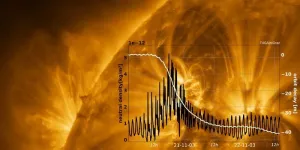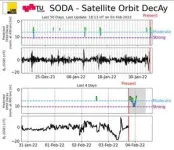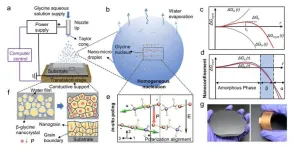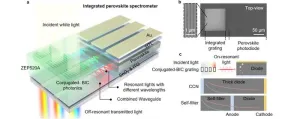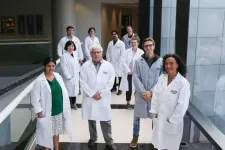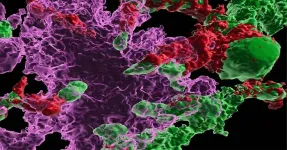(Press-News.org) After a successful test phase, the Satellite Orbit DecAy (SODA) service, which was jointly developed by TU Graz and the University of Graz, officially became part of the ESA’s Space Safety Programme in mid-July. SODA provides accurate forecasts of the effects of solar storms on low Earth orbiting satellites. This makes TU Graz only the third Austrian institution contributing to this ESA programme. Seibersdorf Laboratories, and the University of Graz, through the Kanzelhöhe Observatory and the Institute of Physics, have previously already been involved in the agency’s work.
The new forecast service is freely available via the ESA Space Weather Service and offers a warning with a lead time of around 15 hours. The commissioning of SODA is of particular interest at this stage since the solar activity is expected to reach its maximum within the next two years. The extent to which solar storms can affect satellite orbits has already been demonstrated in SWEETS, a project funded by the Austrian Research Promotion Agency (FFG), on whose findings SODA is based. For the SWEETS project, atmospheric density data was combined with real-time measurements of solar wind plasma and the interplanetary magnetic field to calculate the effects of solar events. This research has shown that large coronal mass ejections have the capability to trigger satellite orbit decays of up to 40 metres for satellites at an altitude of 490 kilometres. In early February 2022, 38 Starlink satellites were even lost shortly after launch at an altitude of 210 kilometres due to a solar storm.
Solar activity reaches its maximum
Such losses of altitude largely occur because the charged plasma particles emitted by the Sun strike the Earth's magnetic field and cause a heating and expansion of the upper layers of the Earth's atmosphere. As a result, the atmospheric drag increases and subsequently causes satellites to lose speed and altitude. In light of the upcoming solar maximum, the ESA has already increased the altitude of some of its satellites by a few kilometres to get through this period safely. Accordingly, the predictions provided by SODA are intended to add an additional level of security. TU Graz contributed its expertise in the processing of satellite data available at the Institute of Geodesy, while the University of Graz’s involvement was based on its experience in the field of solar and heliospheric physics as well as interplanetary magnetic field observation.
The team led by Sandro Krauss from the Institute of Geodesy at TU Graz reviewed atmospheric densities over a 20-year period. For this purpose, they processed data from several low Earth orbit satellite missions, including CHAMP, GRACE, GRACE Follow-on and Swarm. At the University of Graz, a group led by Manuela Temmer from the Institute of Physics analysed around 300 solar storms catalogued between 2002 and 2017 based on measurements of the interplanetary magnetic field by probes at the L1 Lagrange point, which is about 1.5 million kilometres from the Earth in the direction of the Sun. TU Graz afterwards used the information to relate the atmospheric density variations to these solar storms. The forecasting model SODA was developed from the joint analysis of these interdisciplinary datasets.
Space research – highly valued in Austria
"I am very pleased that, through SODA, TU Graz, together with Uni Graz and Seibersdorf Laboratories, is now the third Austrian institution to contribute to ESA's Space Safety Programme," says Sandro Krauss from the Institute of Geodesy at TU Graz. "Of the five Expert Service Centres that constitute the ESA Space Weather Service Network, Austria is now represented in four, with only the United Kingdom involved in all five. This clearly underscores just how highly valued space research is in Austria. The partnership with the University of Graz on this project also provides proof of how valuable interdisciplinary research work is. And we are already working together to further improve SODA."
Manuela Temmer from the Institute of Physics at the University of Graz explained: “For Uni Graz and TU Graz, supplying ESA with this service is a welcome recognition of our work. I am also pleased that our partnership will continue as we work to improve SODA together within the framework of the FFG-funded project CASPER. It will help us to gain a better understanding of more complex solar storms, such as situations where two storms overlap on their way to Earth. We would also like to calculate the atmospheric density at altitudes of 450 and 400 kilometres – 490 kilometres is the lowest altitude we can calculate the density for so far. Since the field of solar storm forecasting is not yet very well researched, we are looking forward to some interesting insights."
END
Space weather and satellite security: Graz University of Technology and University of Graz supply new forecasting service for the ESA's Space Safety Programme
The effects of solar storms on the Earth's atmosphere can cause satellites to crash. To prevent this from happening, the European Space Agency (ESA) is now using SODA, a forecasting service developed in Graz
2023-08-10
ELSE PRESS RELEASES FROM THIS DATE:
New high-tech microscope using AI successfully detects malaria in returning travelers
2023-08-10
Each year, more than 200 million people fall sick with malaria and more than half a million of these infections lead to death. The World Health Organization recommends parasite-based diagnosis before starting treatment for the disease caused by Plasmodium parasites. There are various diagnostic methods, including conventional light microscopy, rapid diagnostic tests and PCR.
The standard for malaria diagnosis, however, remains manual light microscopy, during which a specialist examines blood films with a microscope to confirm the presence of malaria parasites. ...
HKUST researchers pioneers technique to self-assemble high-performance biomolecular films
2023-08-10
A research team led by The Hong Kong University of Science and Technology (HKUST) has developed a novel technique to self-assemble a thin layer of amino acids with ordered orientation over a large area that demonstrates high piezoelectric strength, making the manufacturing of biocompatible and biodegradable medical microdevices, such as pacemaker and implantable biosensor, in the near future possible.
The generation of bioelectricity from the piezoelectric effect – reversible conversion between mechanical and electrical energies – has physiological significance in living systems. ...
A platform for integrated spectrometers based on solution-processable semiconductors
2023-08-10
Acquiring real-time spectral information in point-of-care diagnosis, internet-of-thing, and other lab-on-chip applications require spectrometers with hetero-integration capability and miniaturized feature. Compared to conventional semiconductors integrated by heteroepitaxy, solution-processable semiconductors provide a much-flexible integration platform due to their solution-processability, and, therefore, more suitable for the multi-material integrated system. However, solution-processable semiconductors are usually incompatible with the micro-fabrication processes, making them far from practical use in various lab-on-chip applications.
In a new paper published ...
Researchers develop novel technology to quantify protein critical to blood clot formation through breath gas analysis
2023-08-10
Immunothrombosis, or the formation of microscopic blood clots during inflammation, is a major cause of morbidity among patients with sepsis or severe COVID-19. A key enzyme in this process is thrombin. To date, no method exists for early detection of immunothrombosis in a living organism.
A team of investigators led by Ali Hafezi-Moghadam, MD, PhD, director of the Molecular Biomarkers Nano-Imaging Laboratory (MBNI) at Brigham and Women’s Hospital, a founding member of Mass General Brigham healthcare system, and an associate professor of Radiology at Harvard Medical School, developed a novel technology to diagnose immunothrombosis by measuring ...
C-Path welcomes Sanofi to its Type 1 Diabetes Consortium to help advance drug development
2023-08-10
TUCSON, Ariz., August 9, 2023 — Critical Path Institute (C-Path) announced today that Sanofi, a global leader in immunology and diabetes care, has joined its Type 1 Diabetes Consortium (T1DC). Sanofi joins T1DC as part of its commitment to push the boundaries of innovation to improve the lives of those with diabetes.
T1DC was established in 2017 with the goal to significantly advance the drug development landscape for T1D prevention and treatment. The consortium achieves this by fostering ...
How sure is sure? Incorporating human error into machine learning
2023-08-10
Researchers are developing a way to incorporate one of the most human of characteristics – uncertainty – into machine learning systems.
Human error and uncertainty are concepts that many artificial intelligence systems fail to grasp, particularly in systems where a human provides feedback to a machine learning model. Many of these systems are programmed to assume that humans are always certain and correct, but real-world decision-making includes occasional mistakes and uncertainty.
Researchers from the University of Cambridge, along with The Alan Turing Institute, Princeton, and Google DeepMind, have been attempting ...
Large study suggests people with low levels of vitamin K have less healthy lungs
2023-08-10
People with low levels of vitamin K in their blood are more likely to have poor lung function and to say they suffer with asthma, chronic obstructive pulmonary disease (COPD) and wheezing, according to a study published today (Thursday) in ERJ Open Research [1].
Vitamin K is found in leafy green vegetables, vegetable oils and cereal grains. It plays a role in blood clotting, and so helps the body to heal wounds, but researchers know very little about its role in lung health.
Researchers say their new findings do not alter the current advice on vitamin K intake, but they do support further research to ...
Sanford Burnham Prebys Cancer Center earns merit extension from NCI
2023-08-10
Sanford Burnham Prebys’ Cancer Center has received a rare and prestigious Merit Extension Award from the National Cancer Institute (NCI), recognizing and rewarding its earlier accomplishments as well as current research plans. The award extends the center’s current 5-year Cancer Center Support Grant (CCSG) for an additional two years.
There are only seven Basic Laboratory Cancer Centers in the NCI’s national network. These centers focus primarily on laboratory research: developing, conducting, translating and advancing fundamental discoveries to clinical testing and, ultimately, ...
Stem cell therapy rescues symptoms of Alzheimer’s disease
2023-08-09
In the ongoing search for a cure for Alzheimer’s disease, a burgeoning branch of medicine is bringing new hope. Stem cell therapies are already being used to treat various cancers and disorders of the blood and immune system. In a new proof-of-concept study, scientists at University of California San Diego show stem cell transplants may also be a promising therapeutic against Alzheimer’s.
In the study, publishing this month in Cell Reports, the researchers demonstrate that transplanting hematopoietic ...
Penn Medicine neuroscientists identify brain mechanism that drives focus despite distractions
2023-08-09
PHILADELPHIA—Trying to finish your homework while the big game is on TV? “Visual-movement” neurons in the front of your brain can help you stay focused, according to a new study from neuroscientists in the Perelman School of Medicine at the University of Pennsylvania.
In the study, published recently in Neuron, the scientists sought to illuminate the neural mechanism that helps the brain decide whether to focus visual attention on a rewarding task or an alluring distraction. By analyzing neuron activity in animal models as they faced this kind of attentional ...
LAST 30 PRESS RELEASES:
New study explains the link between long-term diabetes and vascular damage
Ocean temperatures reached another record high in 2025
Dynamically reconfigurable topological routing in nonlinear photonic systems
Crystallographic engineering enables fast low‑temperature ion transport of TiNb2O7 for cold‑region lithium‑ion batteries
Ultrafast sulfur redox dynamics enabled by a PPy@N‑TiO2 Z‑scheme heterojunction photoelectrode for photo‑assisted lithium–sulfur batteries
Optimized biochar use could cut China’s cropland nitrous oxide emissions by up to half
Neural progesterone receptors link ovulation and sexual receptivity in medaka
A new Japanese study investigates how tariff policies influence long-run economic growth
Mental trauma succeeds 1 in 7 dog related injuries, claims data suggest
Breastfeeding may lower mums’ later life depression/anxiety risks for up to 10 years after pregnancy
Study finds more than a quarter of adults worldwide could benefit from GLP-1 medications for weight loss
Hobbies don’t just improve personal lives, they can boost workplace creativity too
Study shows federal safety metric inappropriately penalizes hospitals for lifesaving stroke procedures
Improving sleep isn’t enough: researchers highlight daytime function as key to assessing insomnia treatments
Rice Brain Institute awards first seed grants to jump-start collaborative brain health research
Personalizing cancer treatments significantly improve outcome success
UW researchers analyzed which anthologized writers and books get checked out the most from Seattle Public Library
Study finds food waste compost less effective than potting mix alone
UCLA receives $7.3 million for wide-ranging cannabis research
Why this little-known birth control option deserves more attention
Johns Hopkins-led team creates first map of nerve circuitry in bone, identifies key signals for bone repair
UC Irvine astronomers spot largest known stream of super-heated gas in the universe
Research shows how immune system reacts to pig kidney transplants in living patients
Dark stars could help solve three pressing puzzles of the high-redshift universe
Manganese gets its moment as a potential fuel cell catalyst
“Gifted word learner” dogs can pick up new words by overhearing their owners’ talk
More data, more sharing can help avoid misinterpreting “smoking gun” signals in topological physics
An illegal fentanyl supply shock may have contributed to a dramatic decline in deaths
Some dogs can learn new words by eavesdropping on their owners
Scientists trace facial gestures back to their source. before a smile appears, the brain has already decided
[Press-News.org] Space weather and satellite security: Graz University of Technology and University of Graz supply new forecasting service for the ESA's Space Safety ProgrammeThe effects of solar storms on the Earth's atmosphere can cause satellites to crash. To prevent this from happening, the European Space Agency (ESA) is now using SODA, a forecasting service developed in Graz
